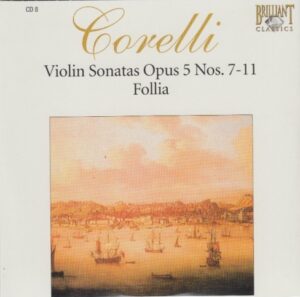 This morning, as I sit here at Panera (not in my usual seat, mind you, which throws me all off), sipping my Light Roast coffee with cinnamon, and long after I’ve scarfed down my sesame seed bagel with chive and onion cream cheese, I’m listening to the eighth CD in the 10-CD box set by the incomparable Brilliant Classics label.
This morning, as I sit here at Panera (not in my usual seat, mind you, which throws me all off), sipping my Light Roast coffee with cinnamon, and long after I’ve scarfed down my sesame seed bagel with chive and onion cream cheese, I’m listening to the eighth CD in the 10-CD box set by the incomparable Brilliant Classics label.
At first, it was pretty much business as usual, with music slightly more melodic than previous installments.
So, I listened while I researched Scottish Baptist preacher Alexander McLaren‘s sermons (for my own edification, not for a seminary class), and suddenly I sat up straighter and took notice.
Something I heard had caught my attention in a big way.
I quickly looked at my Music (formerly known as iTunes) program and discovered that I was listening to Track 23 (the last track) titled “Follia.”
What was this?!?!?!
 I looked at the back of the CD sleeve, hoping for more information. Nope. Not even any recording date for these compositions.
I looked at the back of the CD sleeve, hoping for more information. Nope. Not even any recording date for these compositions.
So, I looked through the meager booklet that came with the box set. There, I found information about Corelli I hadn’t really noticed before. And I found a short bi0graphy of what the booklet refers to as “La Folia,” but which the back of the CD sleeve lists as “Follia.”
Which one is correct? Or are both correct?
Here’s what I discovered about my new-found favorite composition.
Just the Facts
CD 8 of this 10-CD box set consists of 23 tracks that clock in at 56:17.
According to the information on the back of the box, the music was performed by Musica Amphion, conducted by Pieter-Jan Belder, lead by Remy Baudet.
I hadn’t heard of Musica Amphion before starting this project. According to the booklet in the box set,
Musica Amphion, founded by harpsichordist/recorder play Pieter-Jan Belder, focuses on performing 17th and 18th century orchestral and chamber music on original instruments.
Remy Baudet, violin
Jaap ter Linden, cello
Mike Fentross, theorbo and guitar
Pieter-Jan Belder, harpsichord
If the information on the back of the box holds true for all performances, these were recorded in the summer, 2004.
I noticed a dedication on the back of the CD sleeve: “to Electress Sophie Charlotte of Brandenburg.”
Not knowing who that was, I looked her up and discovered an entry on Wikipedia:
Sophia Charlotte of Hanover (30 October 1668 – 1 February 1705) was the first Queen consort in Prussia as wife of King Frederick I. She was the only daughter of Elector Ernest Augustus of Hanover and his wife Sophia of the Palatinate. Her eldest brother, George Louis, succeeded to the British throne in 1714 as King George I.
The composer Arcangelo Corelli dedicated his Op. 5 sonatas for solo violin (Rome, 1700) to her. By some reports she disliked her husband’s elaborate ceremonies so much that during their coronation she took pinches of snuff to provide herself with “some pleasant distraction”.
While on a visit to her mother in Hanover, Sophia Charlotte died of pneumonia on 1 February [O.S. 21 January] 1705, when she was 36 years of age.
See what I learn doing these projects?
The recording is marked DDD, which means it is an all-digital recording. (Digitally recorded, Digitally mixed, and Digitally mastered.) Purists, those folks who think vinyl sounds better than CDs (they’re wrong) would probably look askance at this recording. To my ears, this is the best way to record music to precisely capture every note. But what do I know?
But I still don’t know what “La Folia” or “Follia” is. So, I Googled that composition and discovered that the phrase means “folly” and, according to an article on BBC, the question arises: “Could La Folia be history’s most enduring tune?”
I also discovered that the various spellings can be attributed to either Spanish (“La Folia”) or Italian (“Follia”).
Wikipedia features an informative and interesting article about it. You can read it here.
Just the Feelings
Recording quality: 5
Overall musicianship/vocals: 5
CD liner notes: 2
How does this make me feel: 5
“Follia” or “La Folia” (Track 23) is enough to make this CD worth listening to. It’s lively, fun, and, as I found out, historically important.
And standout track was #10 (“Sonata 9 in A major, Giga, allegro”). It offers a hint of a melody and tempo that reminds me of an Irish jig.
Overall, CD 8 of this 10-CD box set is remarkable. The recording is, as always, first rate. The performances are impeccable. And the music selections are captivating.
